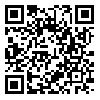Volume 20 - Special-Issue on Occupational Therapy
Iranian Rehabilitation Journal 2022, 20 - Special-Issue on Occupational Therapy: 65-78 |
Back to browse issues page
Download citation:
BibTeX | RIS | EndNote | Medlars | ProCite | Reference Manager | RefWorks
Send citation to:



BibTeX | RIS | EndNote | Medlars | ProCite | Reference Manager | RefWorks
Send citation to:
Ashrafi S, Shabaani Mehr M, Khaleghdoost Mohammadi T, Jafroudi S, Kazemnezhad Leyli E. Effect of Mirror Therapy on the Motor Recovery in Patients After Stroke: A Randomized Clinical Trial. Iranian Rehabilitation Journal 2022; 20 :65-78
URL: http://irj.uswr.ac.ir/article-1-1405-en.html
URL: http://irj.uswr.ac.ir/article-1-1405-en.html
Effect of Mirror Therapy on the Motor Recovery in Patients After Stroke: A Randomized Clinical Trial
Sadra Ashrafi1 

 , Maryam Shabaani Mehr2
, Maryam Shabaani Mehr2 

 , Tahereh Khaleghdoost Mohammadi *
, Tahereh Khaleghdoost Mohammadi * 

 2, Shirin Jafroudi2
2, Shirin Jafroudi2 

 , Ehsan Kazemnezhad Leyli3
, Ehsan Kazemnezhad Leyli3 




 , Maryam Shabaani Mehr2
, Maryam Shabaani Mehr2 

 , Tahereh Khaleghdoost Mohammadi *
, Tahereh Khaleghdoost Mohammadi * 

 2, Shirin Jafroudi2
2, Shirin Jafroudi2 

 , Ehsan Kazemnezhad Leyli3
, Ehsan Kazemnezhad Leyli3 


1- Student Research Committee, Chronic Kidney Disease Research Center, Shahid Beheshti University of Medical Sciences, Tehran, Iran.
2- Department of Nursing, School of Nursing and Midwifery, Guilan University of Medical Sciences, Rasht, Iran.
3- Social Determinants of Health Research Center, Department of Biostatistics, School of Nursing and Midwifery, Guilan University of Medical Sciences, Rasht, Iran.
2- Department of Nursing, School of Nursing and Midwifery, Guilan University of Medical Sciences, Rasht, Iran.
3- Social Determinants of Health Research Center, Department of Biostatistics, School of Nursing and Midwifery, Guilan University of Medical Sciences, Rasht, Iran.
Abstract: (2680 Views)
Objectives: One of the most important problems seen in patients after stroke is that they cannot develop normal muscle strength. In recent years, the use of Mirror Therapy (MT) in the recovery of this condition has been noticed in different studies. This study investigated the effect of MT on motor recovery in patients after stroke.
Methods: In this clinical trial, 93 patients were divided into three groups, including MT, non-reflective surface, and control groups. The tools used in this study included the patient’s profile questionnaire, Mini-Mental State Examination Test, and Brunnstrom Recovery Stages. After the routine physiotherapy program, the intervention groups underwent MT for 20 sessions. The analysis of data was performed by SPSS software v. 22.
Results: There was a significant difference between the non-reflective surface and MT groups (P=0.043) in pairwise comparison of their motor recovery stages in the 20th session, but the difference between the non-reflective surface and control groups was not significant. There was also a significant statistical difference between the MT and control groups in motor recovery stages in the 20th session, (P=0.0332)
Conclusion: The obtained findings suggest that MT can increase patients’ motor recovery after stroke. This method can be used as a simple, cheap, and usable method at home.
Methods: In this clinical trial, 93 patients were divided into three groups, including MT, non-reflective surface, and control groups. The tools used in this study included the patient’s profile questionnaire, Mini-Mental State Examination Test, and Brunnstrom Recovery Stages. After the routine physiotherapy program, the intervention groups underwent MT for 20 sessions. The analysis of data was performed by SPSS software v. 22.
Results: There was a significant difference between the non-reflective surface and MT groups (P=0.043) in pairwise comparison of their motor recovery stages in the 20th session, but the difference between the non-reflective surface and control groups was not significant. There was also a significant statistical difference between the MT and control groups in motor recovery stages in the 20th session, (P=0.0332)
Conclusion: The obtained findings suggest that MT can increase patients’ motor recovery after stroke. This method can be used as a simple, cheap, and usable method at home.
Article type: Original Research Articles |
Subject:
Physical Medicine and Rehabilitation
Received: 2021/07/1 | Accepted: 2021/11/17 | Published: 2022/01/1
Received: 2021/07/1 | Accepted: 2021/11/17 | Published: 2022/01/1
Send email to the article author
| Rights and permissions | |
 |
This work is licensed under a Creative Commons Attribution-NonCommercial 4.0 International License. |





